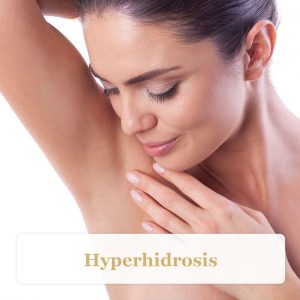Our Toronto Practice Offers BOTOX® Treatments for Excessive Sweating
 While sweating is typically considered to be natural and healthy, some individuals sweat more than others and constantly find themselves contending with stained silk shirts, overly stinky feet, sweaty palms, and uncomfortable, embarrassing social situations.
While sweating is typically considered to be natural and healthy, some individuals sweat more than others and constantly find themselves contending with stained silk shirts, overly stinky feet, sweaty palms, and uncomfortable, embarrassing social situations.
Hyperhidrosis or excessive sweating is a condition that involves overactive sweat glands. Areas most commonly affected include the hands, feet, and armpits. This condition can be very debilitating, both physically and emotionally. Our dermatologists can help you manage hyperhidrosis at our Toronto practice with a variety of treatment options, including BOTOX® injections.
Causes & Occurrences of Hyperhidrosis
The Canadian Dermatology Association estimates that roughly 3 percent of the Canadian population suffers from hyperhidrosis – while that number may seem small, it translates to nearly a million people in the country.
While hyperhidrosis can have a negative impact on everything from confidence, social comfort, work productivity, emotional well-being, and a range of wardrobe choices, only 38 percent of individuals with the condition seek help for it from a health care provider – allowing for the possibility that the actual occurrence of hyperhidrosis within the population is much higher than what is reported.
Hyperhidrosis may be triggered by a variety of causes, such as diabetes or other medical conditions, injury, or hormonal changes. It is simply characterized by the overactivity of sweat glands. Often, those affected by it do not realize that it is a medical condition that can be treated or managed.
Due to the nature of the condition, hyperhidrosis may also be accompanied by a condition of excessive body odor known as osmidrosis, bromhidrosis, or bromidrosis.
Focal vs. Generalized Hyperhidrosis
The cause of focal or primary hyperhidrosis is unknown. As the name suggests, this form of excessive sweating is limited to one or more of the following areas:
- Hands (palmar hyperhidrosis)
- Feet (plantar hyperhidrosis)
- Underarms (axillary hyperhidrosis)
- Face (facial hyperhidrosis)
Hyperhidrosis Treatments
There are a variety of over-the-counter or homemade treatments (such as strong antiperspirants, baking soda etc.) patients would have tried before approaching physicians for help, as well as coping mechanisms such as changing clothes every few hours and padding underarms.
At North York Dermatology Clinic, we offer non-surgical treatments ranging from topical prescription treatments to even BOTOX® injections. To determine which treatment(s) is appropriate for you, it is best to visit our practice for an initial in-person consultation with one of our physicians.
BOTOX® for Primary Hyperhidrosis
Most individuals are familiar with BOTOX® as an anti-aging, wrinkle-reducing injectable, but few are aware of the wide range of therapeutic uses of the botulinum toxin-based neuromodulator – including curbing hyperhidrosis. BOTOX® can be used to reduce excessive sweating in a number of areas, including the face, axilla or armpits, hands, and feet.
BOTOX® for hyperhidrosis works by halting chemical signals from the neurotransmitter acetylcholine. Once the neuromodulator is injected into the specific areas where the excessive sweating typically occurs, it blocks the chemical messages sent from the brain to the sweat glands.
Without the chemical signals to stimulate them, the glands in the treated areas will not produce sweat. Note that this localized form of sweat reduction is not detrimental to the body’s health and function in any way. Other sweat glands will continue to function as they typically do, and the body’s overall thermoregulation system will remain largely unaffected by the reduced sweat production in the treated areas.
Sweat reduction results should be apparent within a month of the first treatment session, with moderate to significant reduction in sweat production. In some cases, it is possible that the injections from the first session may not cover all the sweat glands in a given treatment area, so a follow-up session may be required to achieve the desired results.
The longevity of results from BOTOX® treatments varies from person to person. They can last anywhere between three months to more than half a year, with repeat treatments necessary to maintain the results.
